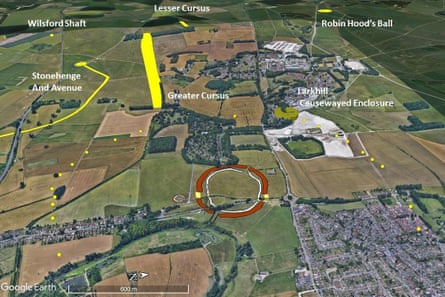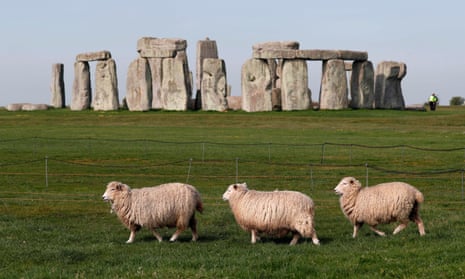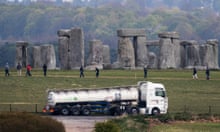Leading archaeologists say a £1.6bn scheme to build a road tunnel through the historic Stonehenge landscape should be scrapped altogether after the sensational discovery nearby of the largest prehistoric structure ever found in Britain.
Mike Parker Pearson, professor of British later prehistory at University College London, said: “This is just another reason to give up this disastrous white elephant of a scheme.”
A giant neolithic structure, created 4,500 years ago, has been uncovered 1.9 miles (3 km) north-east of Stonehenge on Salisbury Plain near Amesbury, Wiltshire. To the astonishment of archaeologists, a series of vast shafts – each more than five metres deep and up to 20 metres across – were found to have been aligned to form a circle 1.2 miles in diameter.
The discovery was made possible by new technology that is yet to play a significant role in our understanding of this extraordinary ancient landscape.
Through geophysical prospection, ground-penetrating radar and magnetometry, the shafts showed up as geophysical anomalies. They had previously been dismissed as natural sinkholes and dew ponds. The technology revealed their true significance.
The potential for technology to reveal so much more is enormous because only a tiny percentage has been explored so far, Parker Pearson said.
While Highways England has argued that its plan to improve the A303 with a tunnel will cut congestion, Parker Pearson said: “The expenses per mile are mind-boggling. It’s a tunnel that’s basically 2.9km long and it’s going to cost £1.6bn.
“Colleagues who work in that business say, ‘You might as well add 40%.’ I think they’re saying [it’ll take] five to seven years to construct, so that would be continuous traffic jams, and there’s concern that the vibrations will actually impact on archaeological deposits, causing the ground to crack.”

Vincent Gaffney of the University of Bradford, co-principal investigator of the Stonehenge Hidden Landscapes Project, which made the discovery while surveying the landscape, has described the discovery as unprecedented. He said: “In a world heritage site as complex as Stonehenge, it is essential that we take sensitive decisions with respect to the best evidence we have, as future generations are unlikely to forgive us if we damage this unique landscape.
“Remote sensing has revolutionised archaeology and the scale at which we now gather data is beginning to transform our knowledge of landscapes, even at Stonehenge, an area we thought we knew well. The new [discovery] is probably the first of many new insights and discoveries. I feel we should consider the implication of these discoveries before a tragic loss ensues.”
Parker Pearson said: “Vince and his team have identified various other shafts that may be part of other formations further over to the west, even nearer Stonehenge. We just don’t know how many other big pits like that there are in the Stonehenge environs.”
He added: “The problem is that this is a scheme that was hatched back in the 1980s, when they really had no idea about the potential of what might be there. Most archaeologists around the world are horrified at what’s going on.”
The government is expected to make a planning decision by 17 July.
Kate Fielden, an archaeologist and honorary secretary to the Stonehenge Alliance, which has campaigned against the tunnel scheme, said: “The astonishing finds we have learned about today serve to underline not only how much there is still to learn about the Stonehenge landscape, but also how much as yet unknown information about our distant past we could lose should the A303 Stonehenge tunnel and expressway go ahead.”
The neolithic structure that has been discovered appears to have been a boundary guiding people to a sacred area, because Durrington Walls, one of Britain’s largest henge monuments, is placed at its centre.
Parker Pearson had previously suggested that Durrington Walls lay within a “domain of the living” separated from a “domain of the ancestors” centred on Stonehenge. He said: “What’s really pleasing for me is that it’s over 20 years now since we put that hypothesis together. Vince has found it. Fantastic. We’ve really got a good idea of what Stonehenge is all about. What a find.”
Derek Parody, Highways England project director for the A303 Stonehenge scheme, said: “The latest finds are in the north-east of the world heritage site, well outside the scheme boundary and at its closest point half a kilometre north of the planned A303 upgrade. In our meticulous planning for the proposed route, we have used ground-penetrating radar as part of our geophysical survey strategy, to Historic England-required standards, and we have also supplemented this with a wealth of trial trenching and test pits to further evidence our results.”










